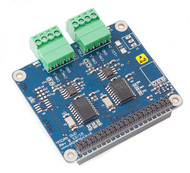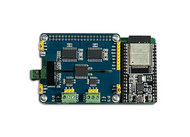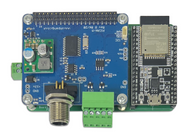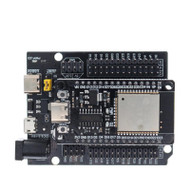Product Description
Free Shipping Within the United States!
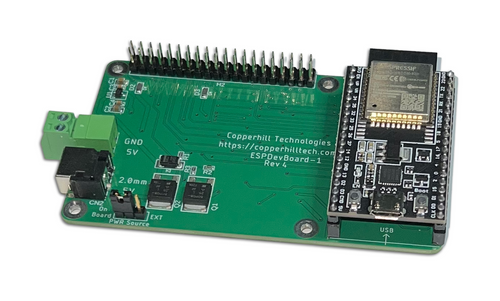 espBerry - ESP32 Extended Functionality through Raspberry Pi HATs
espBerry - ESP32 Extended Functionality through Raspberry Pi HATs
The espBerry DevBoard combines the ESP32-DevKitC development board with any Raspberry Pi HAT by connecting to the onboard RPi-compatible 40-pin GPIO header. The purpose of the espBerry should not be perceived as a Raspberry Pi alternative but as extending the ESP32’s functionality by tapping into the vast offerings of RPi HATs in the market and taking advantage of the multiple and flexible hardware options. The espBerry is the perfect solution for Internet of Things (IoT) applications, especially those requiring wireless capabilities. All open-source code samples take advantage of the popular Arduino IDE with its excellent programming capabilities.
Unleash the powerful ESP32 hardware capabilities to easily connect two CAN ports to Bluetooth, BLE, WiFi, USB, etc.
espBerry Features
- Processor: ESP32 DevKitC
- 32-Bit Xtensa dual-core @240 MHz
- WiFi IEEE 802.11 b/g/n 2.4 GHz
- Bluetooth 4.2 BR/EDR and BLE
- 520 kB SRAM (16 kB for cache)
- 448 kB ROM
- Programmable per USB A/micro-USB B cable
- Raspberry Pi Compatible 40-pin GPIO header
- 20 GPIO
- 2 x SPI
- 1 x UART
- Input Power: 5 VDC
- Reverse polarity protection
- Overvoltage Protection
- Power Barrel Connector Jack 2.00mm ID (0.079″), 5.50mm OD (0.217″)
- Operating Range: -40°C ~ 85°C
- Note: Most RPi HATs operate at 0°C ~ 50°C
- Dimensions: 95 mm x 56 mm – 3.75″ x 2.2″
Complies to Standard Raspberry Pi HAT Mechanical Specifications…
espBerry Variants
The espBerry board is available with four different assembly options:
- Fully assembled with ESP32 DevKitC
- Fully assembled without ESP32 DevKitC
- Unassembled with ESP32 DevKitC
- Unassembled without ESP32 DevKitC
The espBerry uses the ESP32 DevKitC with PCB antenna (Bluetooth, BLE, WiFi) per default. You can order the assembled/unassembled version without the ESP32 DevKitC module if you wish to use the version with external antenna.
If you purchase the variants with the ESP32 DevKitC module, we will test the module prior to delivery.
Getting Started with the ESP32 Development Board
Rather than repeating information already available online, we recommend working through the information Random Nerd Tutorials:
Getting Started with the ESP32 Development Board | Random Nerd Tutorials...
More Resources
Development Resources
Programming Support
Bluetooth & BLE Information
- Adafruit - Bluetooth & BTLE...
- Exploring Bluetooth 5 - Going the Distance...
- The Basics of Bluetooth Low Energy (BLE)...
- Understanding Bluetooth Range...
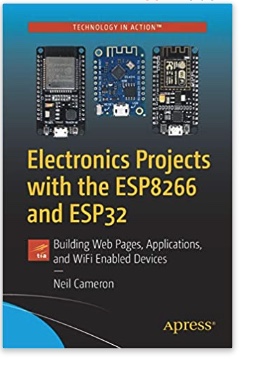 Electronics Projects with the ESP8266 and ESP32: Building Web Pages, Applications, and WiFi Enabled Devices
Electronics Projects with the ESP8266 and ESP32: Building Web Pages, Applications, and WiFi Enabled Devices
Copperhill Technologies highly recommends using this book for your wireless application projects. Yes, many good books and free online resources are available these days, but this is the book we are using. It made our approach to Bluetooth, BLE, and WIFI a breeze. Programming wireless applications without hassles was fun, and we will share them on this web page.
Projects throughout the book utilize the wireless functionality and processing power of the ESP microcontrollers. Projects are built in the Arduino IDE, so you don't need to download other programming software. In addition, mobile apps are now ubiquitous, making the app build projects of the book very relevant, as are the web page design projects.
In Electronics Projects with the ESP8266 and ESP32, you'll see how easy and practical it is to access information over the internet, develop web pages, build mobile apps to remotely control devices with speech recognition, or incorporate Google Maps in a GPS route tracking app.
 Loading... Please wait...
Loading... Please wait...




